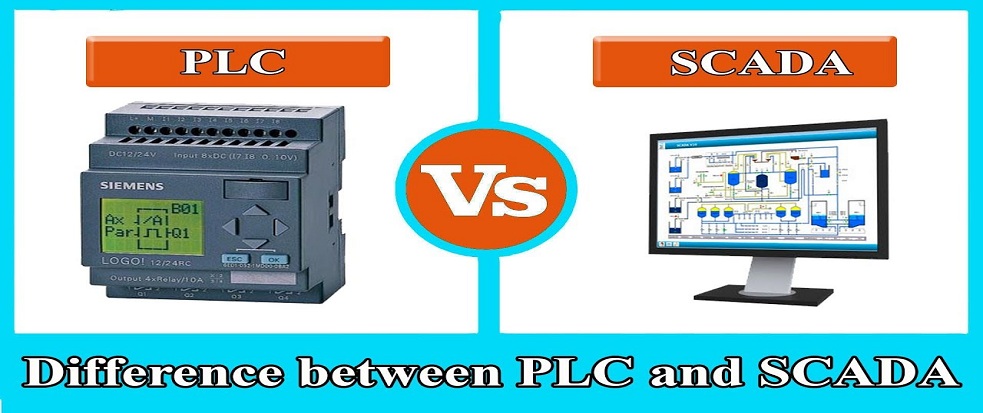PLC
PLC stands for Programmable Logic Controller. A PLC or programmable controller is an industrial digital computer that has been improved and adapted for the control of manufacturing processes, such as assembly lines, robotic devices, or any activity that requires high reliability, ease of programming, and process fault diagnosis.
PLCs share many features of the personal computer you have at home. PLCs play a significant function in the area of automation, using forming part of a larger SCADA system.
SCADA
SCADA stands for Supervisory Control and Data Acquisition. It is a control system architecture comprising computers, networked data communications and graphical user interfaces for high-level process supervisory management. It’s a system of a software element that allows industrial organisations to control industrial processes locally or at remote locations and monitor, gather, and process real-time data.
The basic SCADA architecture begins with programmable logic controllers (PLCs) or remote terminal units (RTUs). PLCs communicate with array objects such as factory machines, HMIs, sensors, and end devices, and then route the information from those objects to computers with SCADA software.
Difference between PLC and SCADA
Function Execution
PLC is essentially a hardware-based system. It’s a computer designed for one specific task of reading field instruments and controlling actuators, motors etc. based on what program has written in it. SCADA is designed to operate on a much broader scale since it can monitor and collect information from every output of a system.
SCADA is imperative a piece of software that is installed on a PC/computer. One of its major functions is to act as Human Machine Interface (HMI).
State
PLC will only focus on monitoring only one element within the system. It is a solid-state device which controls the output of the process through the program given in ladder diagrams.
SCADA is designed to operate on a much broader scale since it can monitor and collect information from every output of a system. It’s software that used to monitor, control and acquire data from field devices even from remote locations.
Hardware
PLC- PLC hardware is designed taking into account harsh industrial environments, requirements of modularity and scalability etc. Programming languages are simple. Programs can be modified online without stopping the PLC or the operations it controls.
SCADA- Using industrial communication networks, like Modbus, the SCADA can be hooked to, usually, a PLC using software drivers that read data in a prescribed format over serial or Ethernet.
Controlling
PLC control systems rely on hardware and immediate connections to effectively manage output devices in an instant when an input device changes state. PLC systems, on the other hand, are driven by instantaneous changes. PLCs have a limited capacity for long-term data storage.
SCADA is a system that relies on computers, software and communication media to remotely monitor and control devices in a control system, usually large-scale. SCADA systems are usually data and decision-driven control systems. The SCADA system used to keep a log of the historical state of these inputs and outputs, which can be used for data analysis or auditing.
Input OR Output
PLC- Input and output represented in normal open (NO), normal close (NC) and coil contacts. The PLC will continue to execute its program, reading inputs, and writing outputs.
SCADA- Input and output represented in images. The data, logged and stored in a SCADA system is typically acquired through communication with the PLC.
Components
PLC- Each component involved is defined using address.
SCADA- Each object is defined using the name.
Relationship between PLC and SCADA
SCADA systems communicate with programmable logic controllers (PLCs) and PID controllers to interact with industrial process plant and equipment.
The PLCs require SCADA to control their operation, whereas the SCADA needs the data collected by the PLCs to do this job effectively. If the system monitors a piece of machinery, the PLC may retrieve data suggests there too much vibration. The PLC will send this data to the SCADA software, which will then inspect the readout data and decide whether adjustments must be made to the operation of the system.
Final Words
PLC (Programmable Logic Controller) is a computing system used to control electromechanical processes. SCADA (Supervisory Control and Data Acquisition) is a type of industrial control system that used to monitor and control facilities and infrastructure in industries.
If you want to know more about PLC & SCADA and willing to have PLC SCADA Training in Noida, then you need to join PLC SCADA Course in Noida for best results. If you are looking for the best platform for PLC SCADA Training in Noida, then you can go with Aptron PLC SCADA Training Institute in Noida. Aptron is the best learning place; we wish you for best and keep learning.
Related Courses-
Industrial Automation Training in Noida

